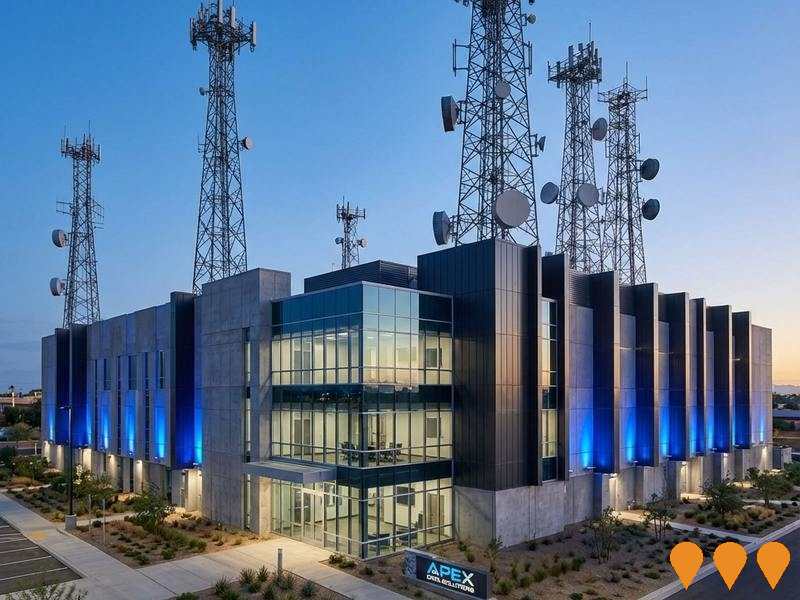Chart Color Schemes
est. as @ -- *
ABS ERP | -- people | --
2021 Census | -- people
Sales Activity
Curious about local property values? Filter the chart to assess the volume and appreciation (including resales) trends and regional comparisons, or scroll to the map below view this information at an individual property level.
Find a Recent Sale
Sales Detail
Population
Cobram has seen population growth performance typically on par with national averages when looking at short and medium term trends
Cobram's population, as of August 2025, is approximately 6,974, a figure that reflects an increase of 509 people since the 2021 Census. This growth represents a 7.9% rise from the previous census figure of 6,465. The change can be inferred from the estimated resident population of 6,600 in June 2024 and an additional 195 validated new addresses since the Census date. This results in a population density ratio of 52 persons per square kilometer. Cobram's growth rate exceeded that of its SA4 region (2.6%) and SA3 area, positioning it as a growth leader in the region. Interstate migration contributed approximately 69.7% of overall population gains during recent periods.
AreaSearch uses ABS/Geoscience Australia projections for each SA2 area, released in 2024 with a base year of 2022. For areas not covered by this data, AreaSearch employs the VIC State Government's Regional/LGA projections from 2023, adjusting using a method of weighted aggregation of population growth from LGA to SA2 levels. Growth rates by age group are applied across all areas for years 2032 to 2041. Based on projected demographic shifts, Cobram is expected to experience exceptional growth, placing it in the top 10 percent of national regional areas. By 2041, the area's population is projected to expand by 2,826 persons, reflecting a total increase of 35.2% over the 17-year period.
Frequently Asked Questions - Population
Development
Residential development activity is slightly higher than average within Cobram when compared nationally
Cobram averaged approximately 41 new dwelling approvals annually over the past five financial years, from FY21 to FY25, with a total of 205 homes approved during this period. In FY26 up until now, 9 dwellings have been approved. On average, 0.7 new residents per year arrived for each new home over these five years, indicating that new supply has kept pace with or exceeded demand, providing ample buyer choice and creating capacity for population growth beyond current forecasts.
The average construction value of new homes was $460,000. In the current financial year, Cobram has seen $23.0 million in commercial approvals, suggesting steady commercial investment activity. Compared to the rest of Victoria, Cobram shows approximately 75% of the construction activity per person and ranks among the 78th percentile nationally when considering areas assessed.
New building activity comprises 87.0% detached houses and 13.0% attached dwellings, maintaining the area's traditional low-density character with a focus on family homes that appeal to those seeking space. With around 151 people per dwelling approval, Cobram exhibits characteristics of a growth area. Population forecasts indicate that Cobram will gain approximately 2,452 residents by 2041. If current construction levels persist, housing supply may lag behind population growth, potentially intensifying buyer competition and underpinning price growth.
Frequently Asked Questions - Development
Infrastructure
Cobram has emerging levels of nearby infrastructure activity, ranking in the 37thth percentile nationally
Changes to local infrastructure significantly influence an area's performance. AreaSearch has identified six projects likely impacting the area. Key projects include Thompsons Beach and Kennedy Park Precinct Plan, NCN Health Cobram Urgent Care Centre Renovation, Cobram Village, and VICSES Cobram Unit. The following list details those most relevant.
Professional plan users can use the search below to filter and access additional projects.
INFRASTRUCTURE SEARCH
 Denotes AI-based impression for illustrative purposes only, not to be taken as definitive under any circumstances. Please follow links and conduct other investigations from the project's source for actual imagery. Developers and project owners wishing us to use original imagery please Contact Us and we will do so.
Denotes AI-based impression for illustrative purposes only, not to be taken as definitive under any circumstances. Please follow links and conduct other investigations from the project's source for actual imagery. Developers and project owners wishing us to use original imagery please Contact Us and we will do so.
Frequently Asked Questions - Infrastructure
NCN Health Cobram Urgent Care Centre Renovation
Upgrade of the Cobram Urgent Care Centre at NCN Health to expand floor space, add a separate urgent care entry, a new ambulance bay and dual waiting areas, and improve infection control and staff/patient safety. Stage 1 (Urgent Care Centre) opened on March 27, 2024; subsequent internal refurbishments followed on campus.

Cobram Village
A neighbourhood retail centre featuring a 3,800 sqm Coles supermarket, Liquorland, Chemist Warehouse, and specialty retailers, providing convenient shopping in an underserved area within a ~70km radius.
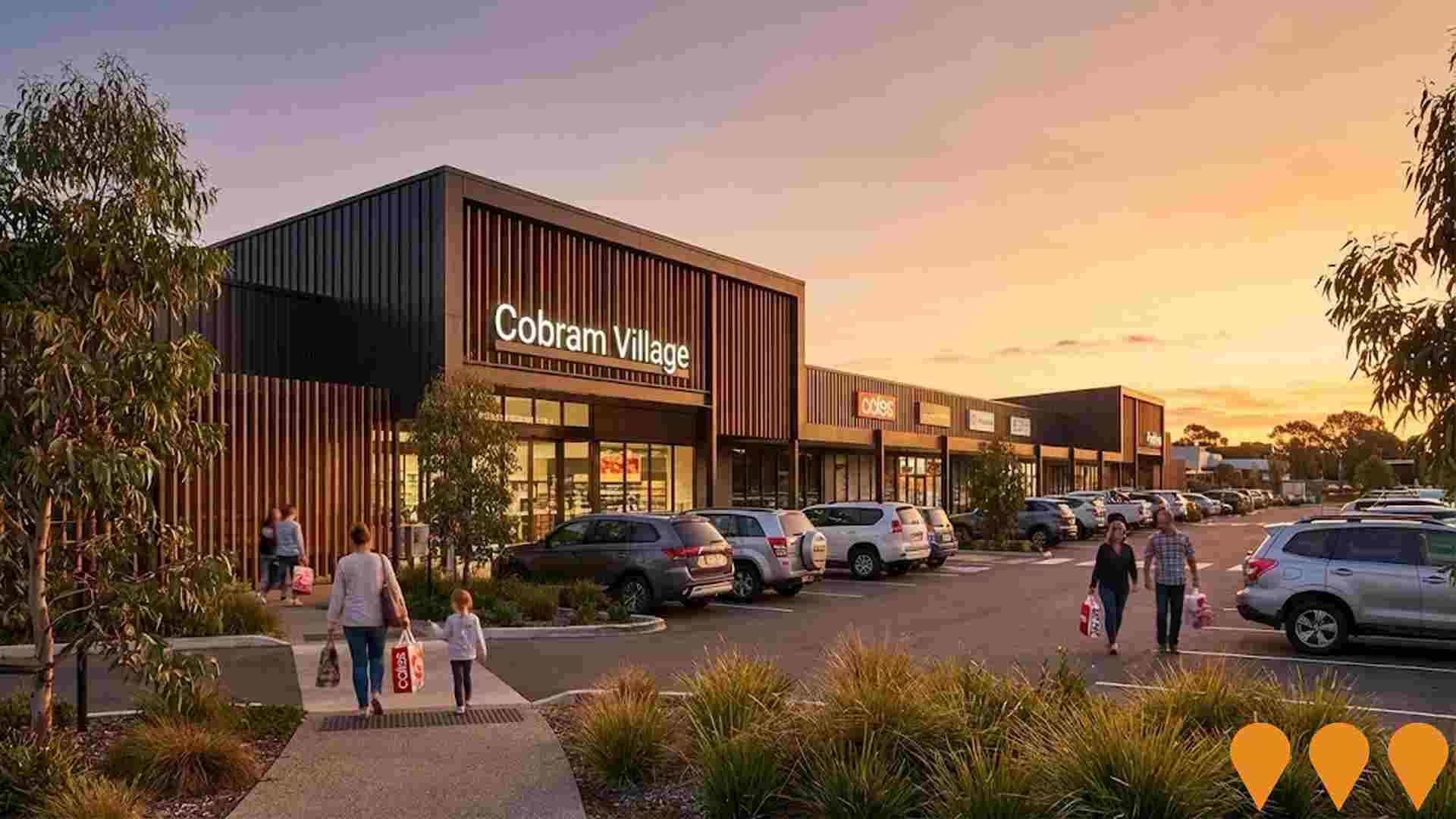
Victorian Renewable Energy Zones
VicGrid, a Victorian Government agency, is coordinating the planning and staged declaration of six proposed onshore Renewable Energy Zones (plus a Gippsland shoreline zone to support offshore wind). The 2025 Victorian Transmission Plan identifies the indicative REZ locations, access limits and the transmission works needed to connect new wind, solar and storage while minimising impacts on communities, Traditional Owners, agriculture and the environment. Each REZ will proceed through a statutory declaration and consultation process before competitive allocation of grid access to projects.
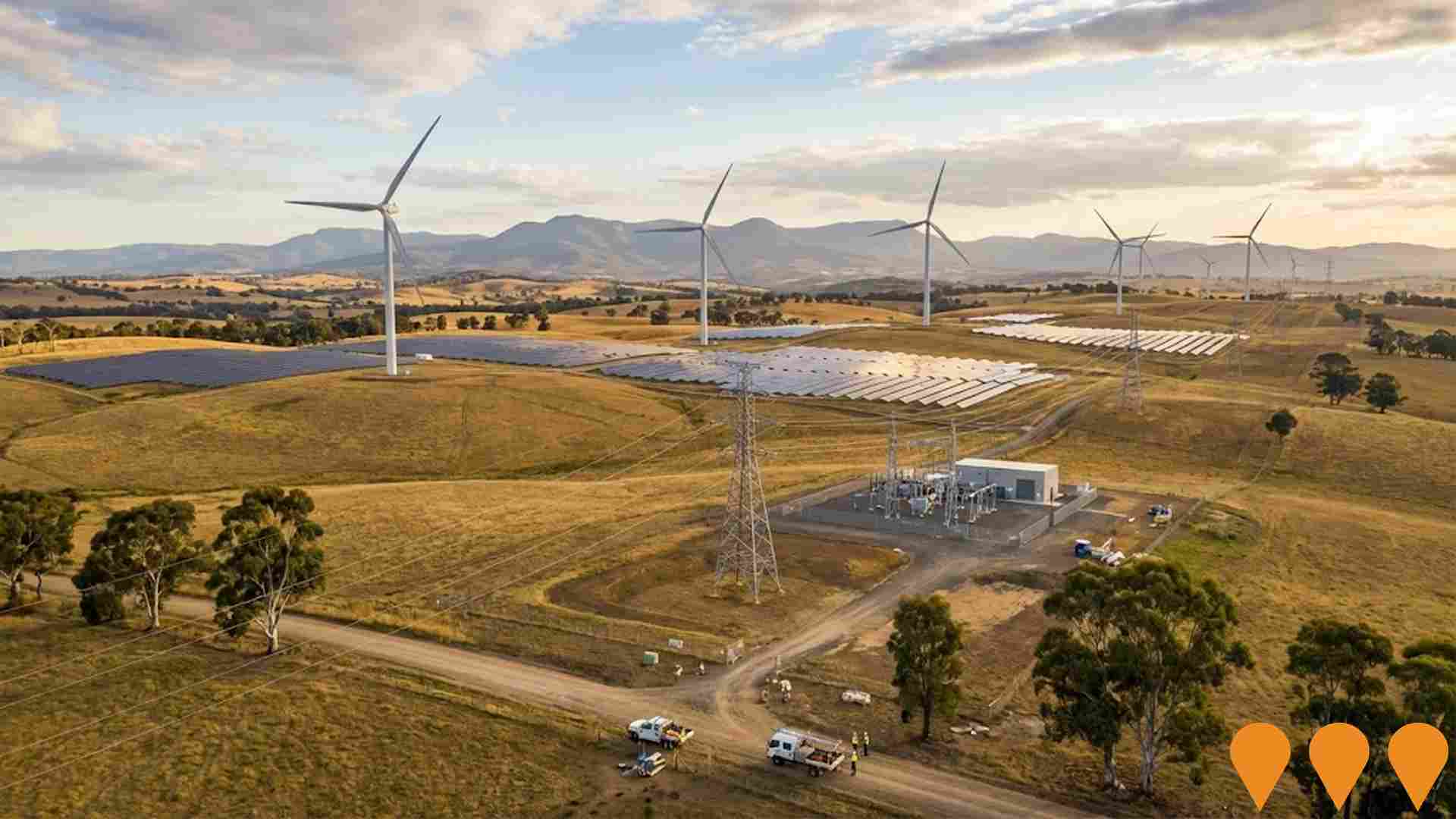
VNI West (NSW section)
NSW portion of the VNI West interconnector: a proposed 500 kV double-circuit transmission line linking Transgrid's Dinawan Substation (near Coleambally) to the NSW/Victoria border north of Kerang, with associated upgrades including works on Transmission Line 51 near Wagga Wagga and expansion works at Dinawan Substation. The NSW Environmental Impact Statement (EIS) is on public exhibition in August 2025, and Transgrid has announced staged delivery with Stage 1 to Dinawan/South West REZ by early 2029 and Stage 2 to the Victorian border aligned to November 2030.
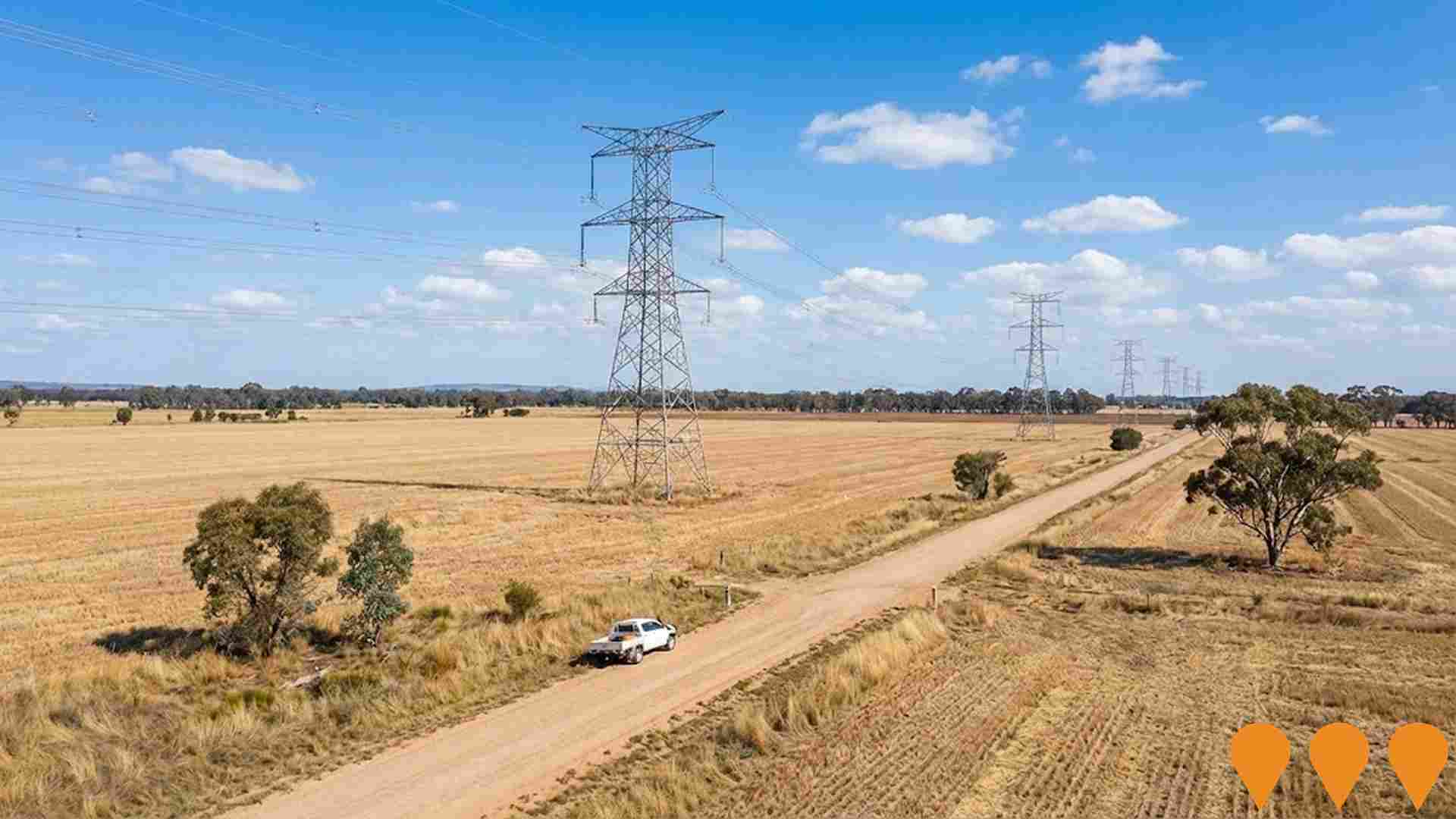
Thompsons Beach and Kennedy Park Precinct Plan
The Thompsons Beach and Kennedy Park Precinct Plan aims to develop a precinct master plan and concept plan to guide future infrastructure developments at the site. It includes reviewing existing partnerships, co-designing a shared governance model, untangling red-tape to remove barriers for tourism and events, enhancing community quality of life through cultural and recreational improvements, boosting productivity via tourism growth and operational efficiencies, and building resilience against ageing infrastructure, extreme weather, and other challenges. The plan will unlock investments in this iconic inland beach destination, drive economic growth, enhance tourism, and strengthen cross-border community connections between NSW and Victoria.
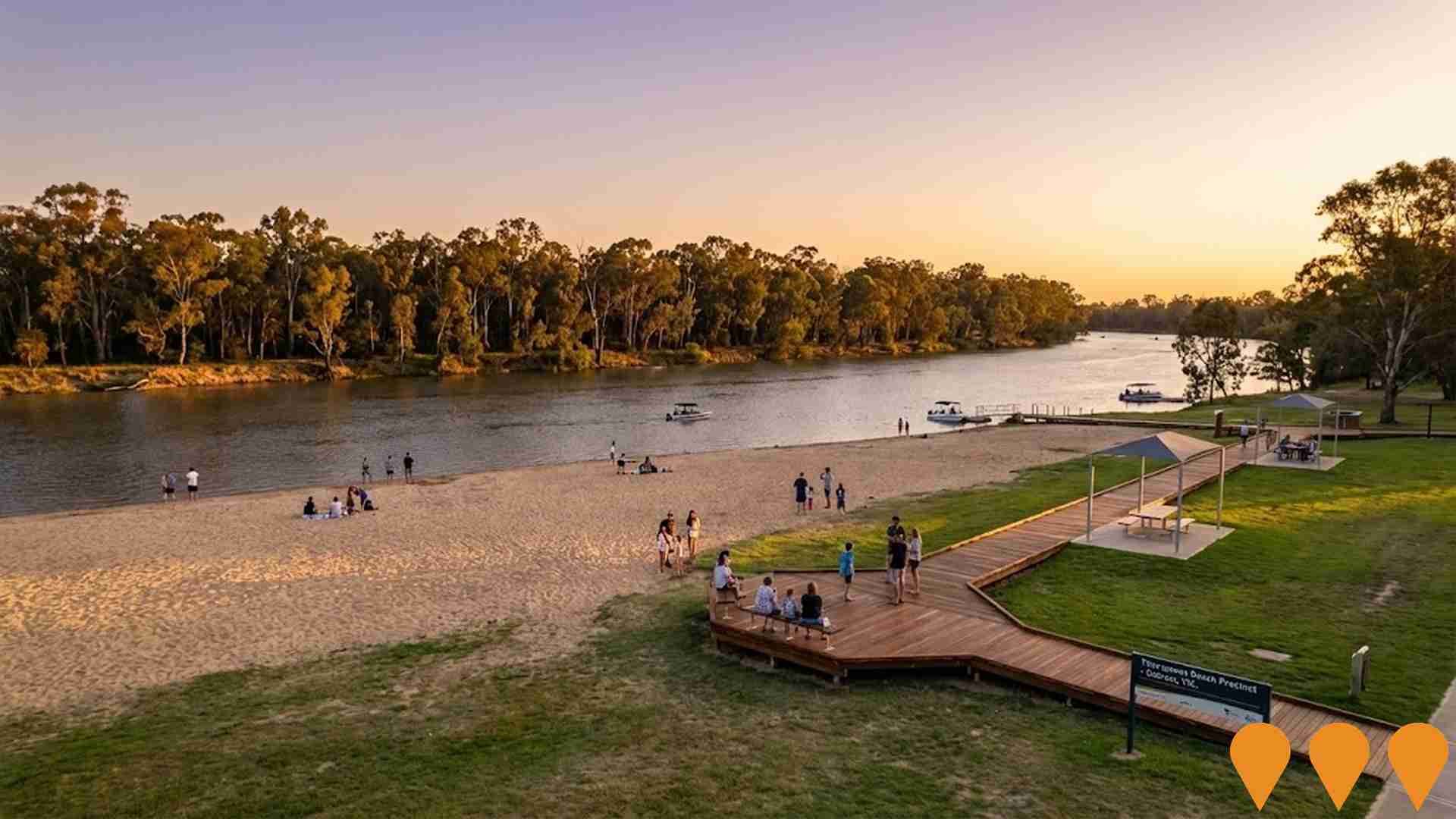
VICSES Cobram Unit
A new fit-for-purpose facility for the VICSES Cobram Unit, featuring four motor bays, office space, communications room, and training areas. It enables effective responses to rescues, floods, storms, and supports local emergency services while aiding volunteer retention and recruitment.
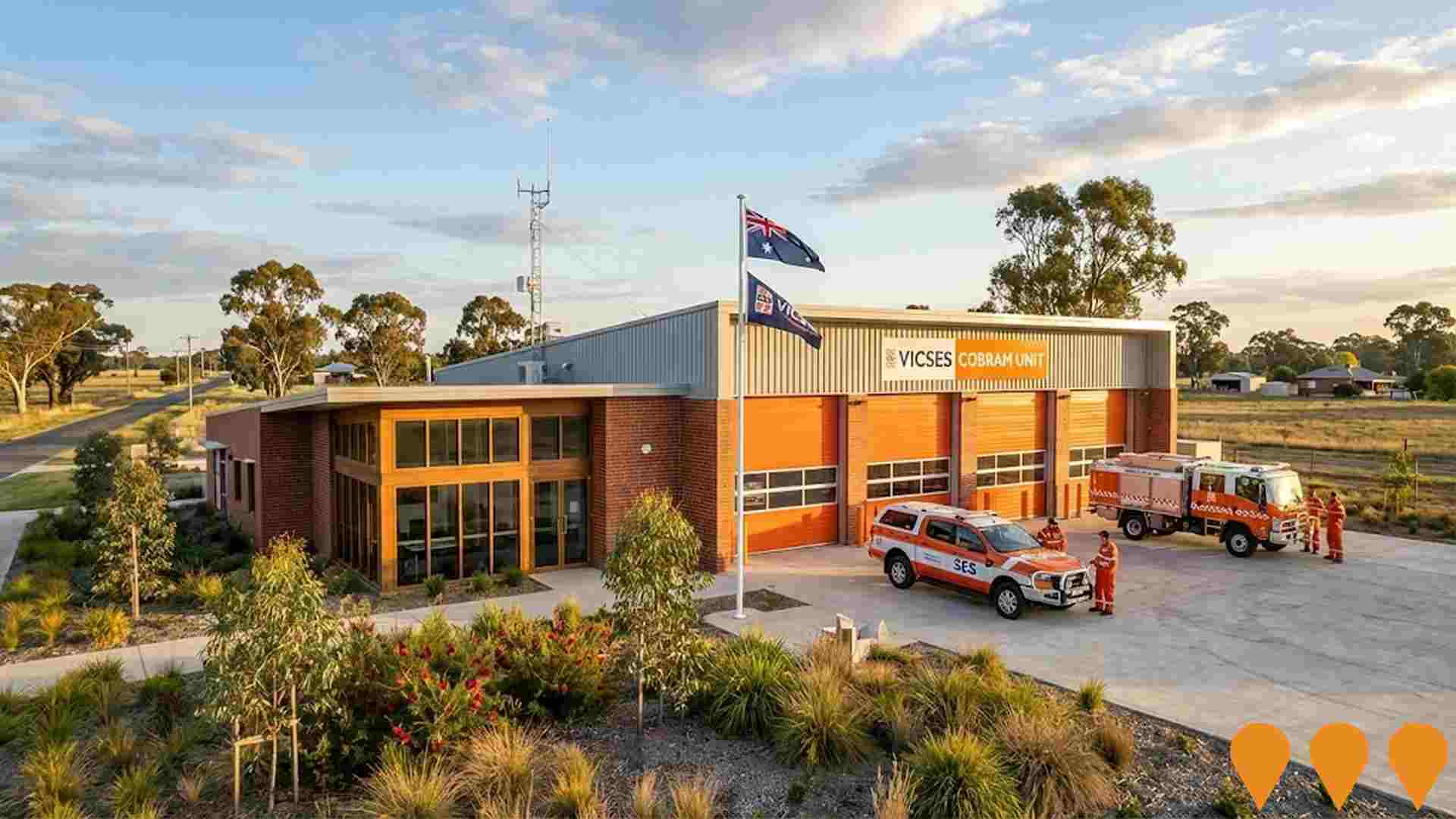
EnergyConnect
Australia's largest energy transmission project. A new ~900km interconnector linking the NSW, SA and VIC grids. NSW-West (Buronga to SA border and Red Cliffs spur) was energised in 2024-2025, connecting the three states via the expanded Buronga substation. NSW-East (Buronga-Dinawan-Wagga Wagga) is under active construction with substation upgrades at Wagga Wagga completed in June 2025 and works well advanced at Dinawan and Buronga. Full 800MW transfer capability is targeted after completion of the eastern section and inter-network testing, expected by late 2027.

Cobram Secondary College Modular Building
Replaced an older building containing asbestos with a new architecturally-designed permanent modular building. Modular facilities require less time for planning and construction, resulting in reduced disruption to students and staff. They are sustainable and innovatively designed, with a comparable lifespan to traditional structures.

Employment
The labour market in Cobram demonstrates typical performance when compared to similar areas across Australia
Cobram has a diverse workforce with both white and blue collar jobs, prominent manufacturing and industrial sectors, and an unemployment rate of 2.3% as of June 2025. This rate is 1.5% lower than the Rest of Vic.'s rate of 3.8%.
The workforce participation in Cobram is 49.3%, compared to Rest of Vic.'s 57.4%. Key employment industries include agriculture, forestry & fishing, manufacturing, and health care & social assistance. Notably, agriculture, forestry & fishing has a high representation with an employment share of 2.1 times the regional level. However, health care & social assistance shows lower representation at 11.3% compared to the regional average of 16.8%.
Many residents commute elsewhere for work based on Census data. In the year to June 2025, Cobram's labour force decreased by 14.3%, and employment declined by 14.9%, leading to a rise in unemployment rate by 0.7 percentage points. This contrasts with Rest of Vic., where employment contracted by 0.9%, the labour force fell by 0.4%, and unemployment rose by 0.4 percentage points. Jobs and Skills Australia's national employment forecasts from May 2025 project a 6.6% expansion over five years and 13.7% over ten years. Applying these projections to Cobram's employment mix suggests local growth of approximately 5.0% over five years and 11.4% over ten years, though these are simple weighting extrapolations for illustrative purposes only.
Frequently Asked Questions - Employment
Income
Income metrics place the area in the bottom 10% of locations nationally according to AreaSearch analysis
According to AreaSearch's aggregation of the latest postcode level ATO data released for financial year 2022, Cobram had a median income among taxpayers of $44,672 with the average level standing at $53,357. This is lower than average on a national basis and compares to levels of $48,741 and $60,693 across Rest of Vic. respectively. Based on Wage Price Index growth of 12.16% since financial year 2022, current estimates would be approximately $50,104 (median) and $59,845 (average) as of September 2025. Census data reveals household, family and personal incomes in Cobram all fall between the 5th and 13th percentiles nationally. Income analysis reveals the $400 - 799 earnings band captures 30.4% of the community (2,120 individuals), contrasting with the broader area where the $1,500 - 2,999 bracket leads at 30.3%. After housing, 85.9% of income remains, though this ranks at only the 8th percentile nationally.
Frequently Asked Questions - Income
Housing
Cobram is characterized by a predominantly suburban housing profile, with a higher proportion of rental properties than the broader region
Cobram's dwelling structure, as per the latest Census, comprised 91.6% houses and 8.4% other dwellings. In comparison, Non-Metro Vic.'s dwelling structure was 90.8% houses and 9.3% other dwellings. Home ownership in Cobram was 45.0%, with the rest being mortgaged (26.3%) or rented (28.7%). The median monthly mortgage repayment in Cobram was $1,278, below Non-Metro Vic.'s average of $1,300. The median weekly rent in Cobram was $250, the same as Non-Metro Vic.'s figure. Nationally, Cobram's mortgage repayments were significantly lower than the Australian average of $1,863, while rents were substantially below the national figure of $375.
Frequently Asked Questions - Housing
Household Composition
Cobram features high concentrations of lone person households, with a lower-than-average median household size
Family households account for 62.3% of all households, including 19.8% that are couples with children, 31.2% that are couples without children, and 10.3% that are single parent families. Non-family households make up the remaining 37.7%, with lone person households at 34.4% and group households comprising 3.5%. The median household size is 2.2 people, which is smaller than the Rest of Vic. average of 2.3.
Frequently Asked Questions - Households
Local Schools & Education
Cobram faces educational challenges, with performance metrics placing it in the bottom quartile of areas assessed nationally
The area faces educational challenges, with university qualification rates at 11.2%, substantially below the VIC average of 33.4%. This presents both a challenge and an opportunity for targeted educational initiatives. Bachelor degrees lead at 8.2%, followed by graduate diplomas at 1.6% and postgraduate qualifications at 1.4%. Trade and technical skills are prominent, with 36.3% of residents aged 15+ holding vocational credentials - advanced diplomas at 9.1% and certificates at 27.2%.
Educational participation is high, with 26.2% of residents currently enrolled in formal education. This includes 9.9% in primary education, 7.7% in secondary education, and 2.1% pursuing tertiary education. Cobram's 5 schools have a combined enrollment reaching 1,478 students as of the latest data. The area demonstrates typical Australian school conditions (ICSEA: 965) with balanced educational opportunities. The educational mix includes 2 primary, 1 secondary, and 2 K-12 schools. School capacity exceeds typical residential needs (21.2 places per 100 residents vs 15.9 regionally), indicating the area serves as an educational center for the broader region.
Frequently Asked Questions - Education
Schools Detail
Nearby Services & Amenities
Transport
Transport servicing is low compared to other areas nationally based on assessment of service frequency, route connectivity and accessibility
Cobram has 19 active public transport stops offering a mix of train and bus services. These stops are served by 13 individual routes, collectively providing 146 weekly passenger trips. Residents have good access to these stops, typically located 299 meters away from the nearest one.
Service frequency averages 20 trips per day across all routes, equating to approximately 7 weekly trips per stop.
Frequently Asked Questions - Transport
Transport Stops Detail
Health
Health performance in Cobram is a key challenge with a range of health conditions having marked impacts on both younger and older age cohorts
Cobram faces significant health challenges with various conditions affecting both younger and older residents. Approximately 47% (~3,277 people) have private health cover, lower than the national average of 55.3%.
The most prevalent medical conditions are arthritis (11.7%) and mental health issues (9.3%). Conversely, 59.7% report no medical ailments, similar to the Rest of Vic's 60.0%. Residents aged 65 and over comprise 28.7% (2,004 people), higher than Rest of Vic's 27.0%. Despite this, health outcomes among seniors are challenging but better than those of the general population.
Frequently Asked Questions - Health
Cultural Diversity
In terms of cultural diversity, Cobram records figures broadly comparable to the national average, as found in AreaSearch's assessment of a number of language and cultural background related metrics
Cobram's cultural diversity aligns with its wider region, with 83.9% citizens, 82.2% born in Australia, and 86.3% speaking English only at home. Christianity is the predominant religion, comprising 57.4%. The 'Other' religious category is overrepresented at 2.2%, compared to 0.7% regionally.
In terms of ancestry, the top groups are English (30.8%), Australian (26.3%), and Italian (9.0%). Notably, Irish (8.7%) and Chinese (2.2%) are overrepresented, while Macedonian remains at regional levels (0.1%).
Frequently Asked Questions - Diversity
Age
Cobram hosts an older demographic, ranking in the top quartile nationwide
Cobram's median age of 48 years is notably older than Rest of Vic.'s median age of 43 and significantly higher than the Australian median age of 38. The age profile indicates that individuals aged 75-84 are particularly prominent, comprising 10.5% of the population, while those aged 35-44 make up a relatively smaller proportion at 10.5%, compared to Rest of Vic.. According to post-2021 Census data, the percentage of individuals aged 15-24 has increased from 9.2% to 10.4%. Conversely, the percentage of those aged 65-74 has decreased from 15.4% to 14.3%. Demographic modeling projects significant changes in Cobram's age profile by 2041, with the 25-34 age cohort expected to expand considerably, growing by 485 people (61%) from 792 to 1,278.



